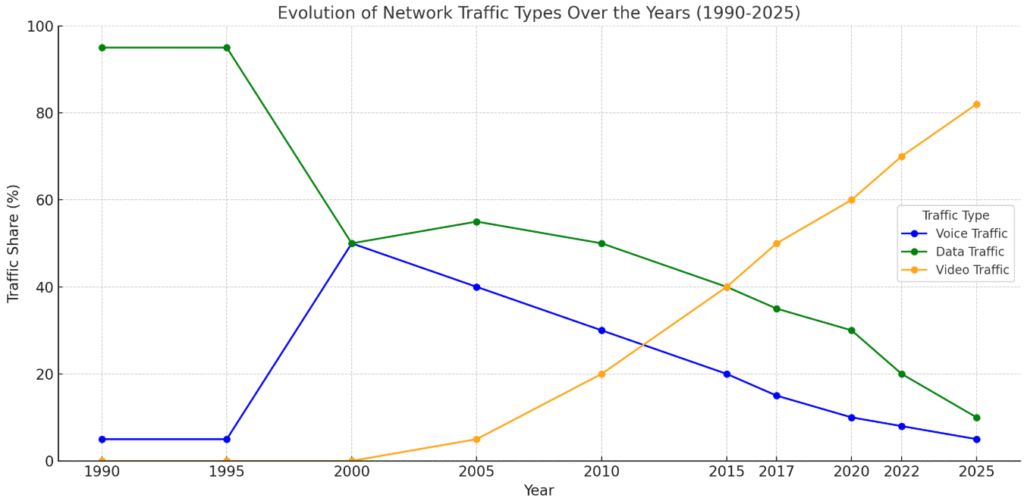Traffic Types
1. Introduction
🔍 Network traffic has transformed significantly over the years.
In the early 2000s, two primary types dominated:
- Voice Traffic: Predictable bandwidth requirements with consistent packet delivery.
- Data Traffic: Non-real-time with varying and unpredictable bandwidth needs.
Today, video traffic has become the largest contributor to global IP traffic, surpassing all others.

🔍 Why is Video Traffic So Dominant?
- Streaming Services: Platforms like Netflix and Disney+ are central to this growth.
- Video Conferencing: Tools like Zoom and Microsoft Teams have made video communication ubiquitous.
- Social Media: Content-heavy platforms like Instagram and Facebook amplify the volume of video traffic.
By 2025, video is projected to make up over 82% of global IP traffic, highlighting the need for Quality of Service (QoS) strategies tailored to video, voice, and data communications.
2. Voice Traffic
🔍 With the rise of Voice over IP (VoIP), voice communication has shifted to IP networks.
While it is now part of regular data traffic, voice remains highly sensitive to delay, jitter, and packet loss, requiring special attention.

🛠️ What Makes Voice Traffic Unique?
- Predictable: Voice traffic relies on audio samples transmitted regularly (every 20 ms).
- Real-Time: Any delay or disruption immediately affects the quality of the conversation. Unlike data, lost packets cannot be retransmitted without disrupting the flow.
✅ Key Characteristics of Voice Traffic:
- Delay (Latency):
- The time it takes for packets to travel from the sender to the receiver.
- QoS Requirement: ≤ 150 ms to maintain natural conversations.
- Jitter:
- Variations in packet arrival times, which can distort audio signals.
- QoS Requirement: ≤ 30 ms to avoid robotic or choppy audio.
- Packet Loss:
- Missing packets result in lost words or syllables.
- QoS Requirement: ≤ 1%.
✅ QoS Requirements for Voice Traffic:
- Latency: ≤ 150 ms.
- Jitter: ≤ 30 ms.
- Packet Loss: ≤ 1%.
3. Video Traffic
🔍 Video traffic is now a cornerstone of modern networks, from streaming movies to video conferencing tools like Zoom.
However, it is both demanding and prone to quality degradation.

🛠️ Major Challenges of Video Traffic:
- High Bandwidth Demand: Video requires significant bandwidth, especially at higher resolutions like HD or 4K.
- Sensitivity to Packet Loss: Even minor disruptions can lead to blurry visuals or audio-video sync issues.
✅ QoS Requirements for Video Traffic:
- Latency: 200–400 ms.
- Jitter: 30–50 ms.
- Packet Loss: 0.1–1%.
- Bandwidth: Ranges from 384 Kbps (low quality) to over 20 Mbps (4K).
⚠️ Without adequate QoS, users experience buffering, blurry images, and frustrating delays.
4. Data Traffic
🔍 Data traffic may not be as time-sensitive as voice or video, but it still plays a crucial role in modern networks and requires careful management.
✅ Characteristics of Data Traffic:
- Error Recovery: Most data traffic uses TCP, which retransmits lost packets to ensure delivery.
- Bandwidth Variability: Some applications, like FTP, consume large amounts of bandwidth, potentially affecting other traffic.
📢 Now that you understand traffic types, let’s explore Classification and Marking!
